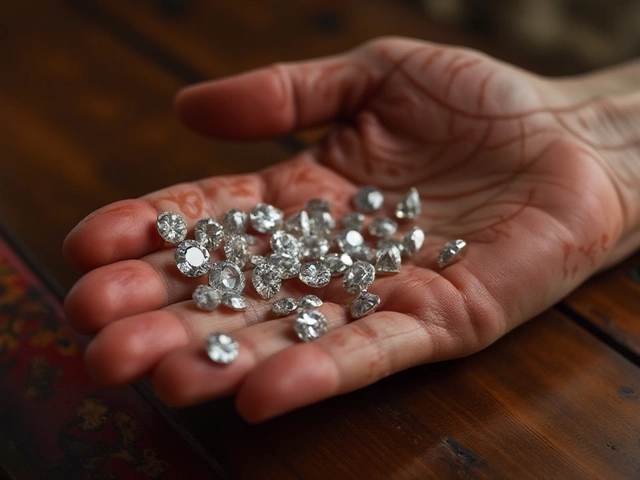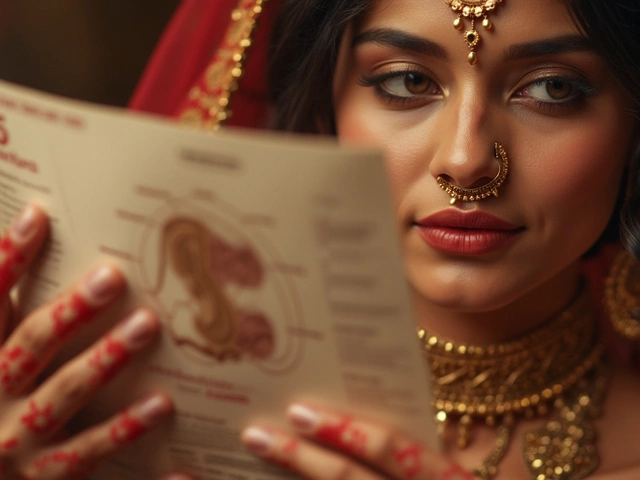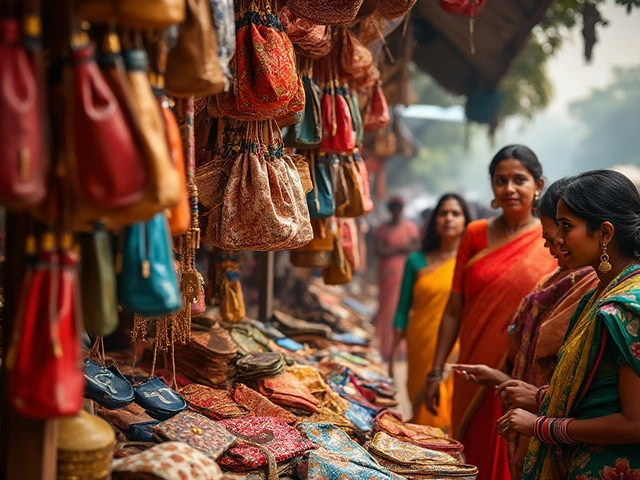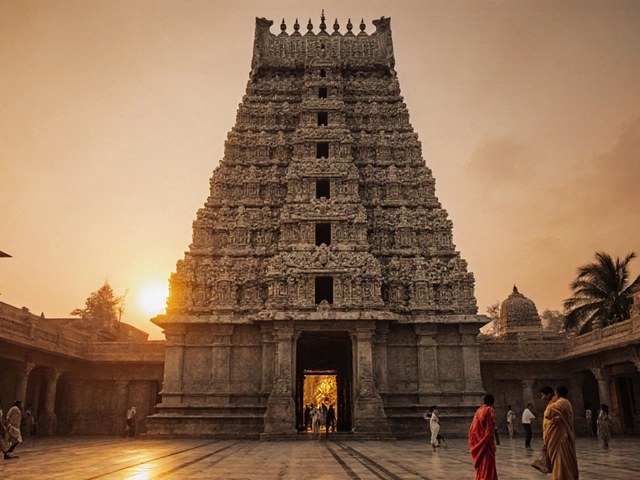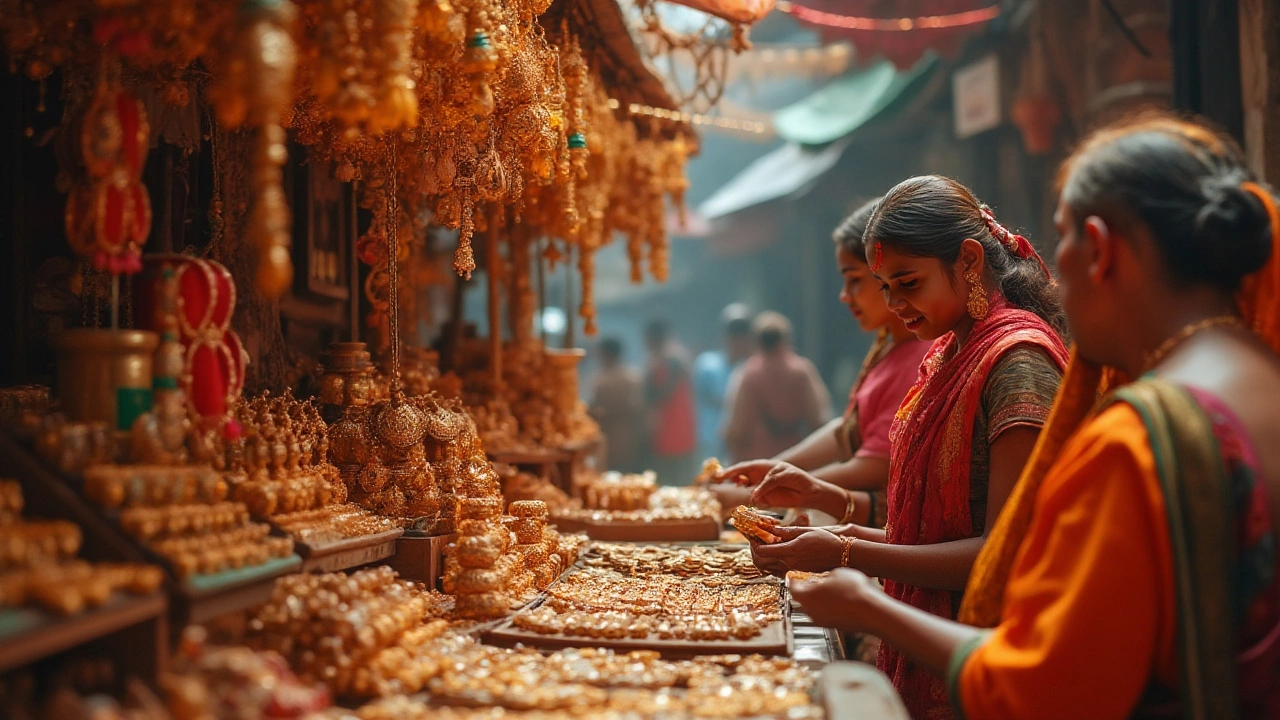
Accessories have played a vital role in defining Indian fashion, offering a vibrant palette of choices that reflect both culture and personal style. Choosing the right accessories can elevate any outfit, whether you're attending a traditional festival or a modern gathering.
Navigating the vast world of Indian accessories, one quickly realizes there's more than meets the eye. From intricate jewelry designs to the colorful interplay of bangles, each element can tell a story or capture a moment.
Finding the perfect balance between modern trends and traditional elegance is key to making a statement. With a few thoughtful considerations and a bit of creativity, accessories can become a powerful tool in expressing one's unique fashion sense.
- Understanding Indian Fashion Accessories
- Choosing the Right Piece for Every Occasion
- Mixing Modern Style with Traditional Elements
- Color Coordination and Style Tips
- Personalizing Your Accessories Collection
Understanding Indian Fashion Accessories
Indian fashion accessories are an extraordinary blend of history, art, and personal expression, each piece often carrying a story that traces back through generations. From the glittering allure of jewelry to the bold statement of modern adornments, these elements play crucial roles in defining style within cultural contexts. Across India, the diverse geography and rich cultural tapestry contribute to varied accessory traditions, each imbued with symbolic meanings and crafted with regional specificity.
Traditionally, jewelry serves not only as a decorative item but also as a significant cultural marker. Pieces such as maang tikka, a headpiece worn on the forehead, reflect deep-rooted customs that hold spiritual significance. Similarly, bangles, often worn in pairs or stacks, are believed to represent prosperity and happiness. While gold is revered and commonly used, intricate craftsmanship with silver, beads, and even glass has emerged from different parts of the country. The evolution of these accessories from traditional to contemporary designs shows an entertaining adaptation of style preferences.
Coco Chanel once said, "Fashion is not something that exists in dresses only. Fashion is in the sky, in the street, fashion has to do with ideas, the way we live, what is happening." This perception is vividly alive within Indian fashion, where cultural and personal narratives intertwine through accessories.
The modern Indian accessory scene is experiencing a dazzling transformation as designers blend traditional elements with contemporary trends. You can see a sari paired with a statement necklace that incorporates both antique design and modern metallic finishes. This approach resonates with the youthful vigor of today's fashion enthusiasts, opening avenues for mixing and matching styles to suit different occasions and moods. Reflecting a growing global influence, fashionistas often incorporate pieces from other cultures, yet the foundation remains deeply rooted in traditional Indian aesthetics.
Accessories are not mere add-ons but pivotal in expressing one's identity through fashion. They offer a creative playground for those looking to highlight unique aspects of their cultural heritage while simultaneously embracing modernity. From daily casual looks to opulent wedding ensembles, understanding the intricate dance between traditional and contemporary fashion accessories brings a new dimension to personal style and expression.
Choosing the Right Piece for Every Occasion
In the world of Indian fashion, the art of choosing the right piece for each occasion is akin to mastering a beautifully choreographed dance. It's not just about picking what catches the eye but understanding how each piece complements the moment, the attire, and even the season. Seasons in India bring with them a dramatic shift not only in climate but also in social calendars, dictating the flow of weddings, festivals, and family gatherings. For example, during Diwali, it's common to see an array of colorful bangles adorning wrists, their multitude of hues reflecting the festive lights. Meanwhile, a wedding might call for a more opulent approach, with heavy necklaces and maang tikka to match the bride's ensemble.
Understanding the cultural significance of events plays a crucial role in accessory selection. Many festivals have deep-rooted traditions that influence choice. A simple example would be the auspicious red and white bangles worn by newlyweds, tying them into cultural symbolism. However, there's also room for modern interpretations. Nowadays, you might see a mix of Western and Indian jewelry styles amalgamated into a single look, creating a dynamic accessorizing statement that appeals to younger generations. It’s this beautiful fusion that allows for personal expression while honoring tradition. As fashion designer Sabyasachi Mukherjee once said,
"In our culture, art is infused into everyday life. A piece of jewelry can tell a story, capturing the essence of a moment."
The time of day can also impact accessorizing choices. Evening ceremonies often invite more sparkling, eye-catching accessories under the soft glowing lights. In contrast, daytime functions might benefit more from subdued tones – pearls, light gold, and pastels complement the natural daylight, adding a touch of elegance. It's about understanding the interplay between light and reflection, where the accessories not only enhance the outfit but the mood of the event. This delicate balance comes from experience and inspiration drawn from myriad sources, be they magazines, social media influencers or family traditions.
Modern fashion also encourages mixing materials and types for a balanced look that feels personal. Combining elements like wood and metal, glass beads and intricate thread work can create layers of interest. Lists of staple accessories, often worn at various occasions, might include items like jhumkas, anklets, or statement rings, each with its own versatility and charm. These pieces can transition from a formal affair to a casual gathering effortlessly when paired thoughtfully with the right attire. Jewelry today is no longer confined to just being accessories but is an integral part of expressing individuality and personality.
Accessorizing isn't just about the grand pieces, though; sometimes it's the subtlety that speaks the loudest. An understated piece can sometimes draw more admiration than the most extravagant one, proving that sometimes less is truly more. Choice accessories that blend harmonious contrast can make an outfit and its wearer unforgettable. Hence, it becomes essential to cultivate an eye for craftsmanship and quality, an aptitude that grows with experience. Eventually, you begin to recognize what pieces resonate best with your style and which are meant for the special occasions they call to mind. Akin to choosing the right words for a story, picking out accessories becomes second nature, an unspoken language that dresses each occasion in its unique fabric of elegance.
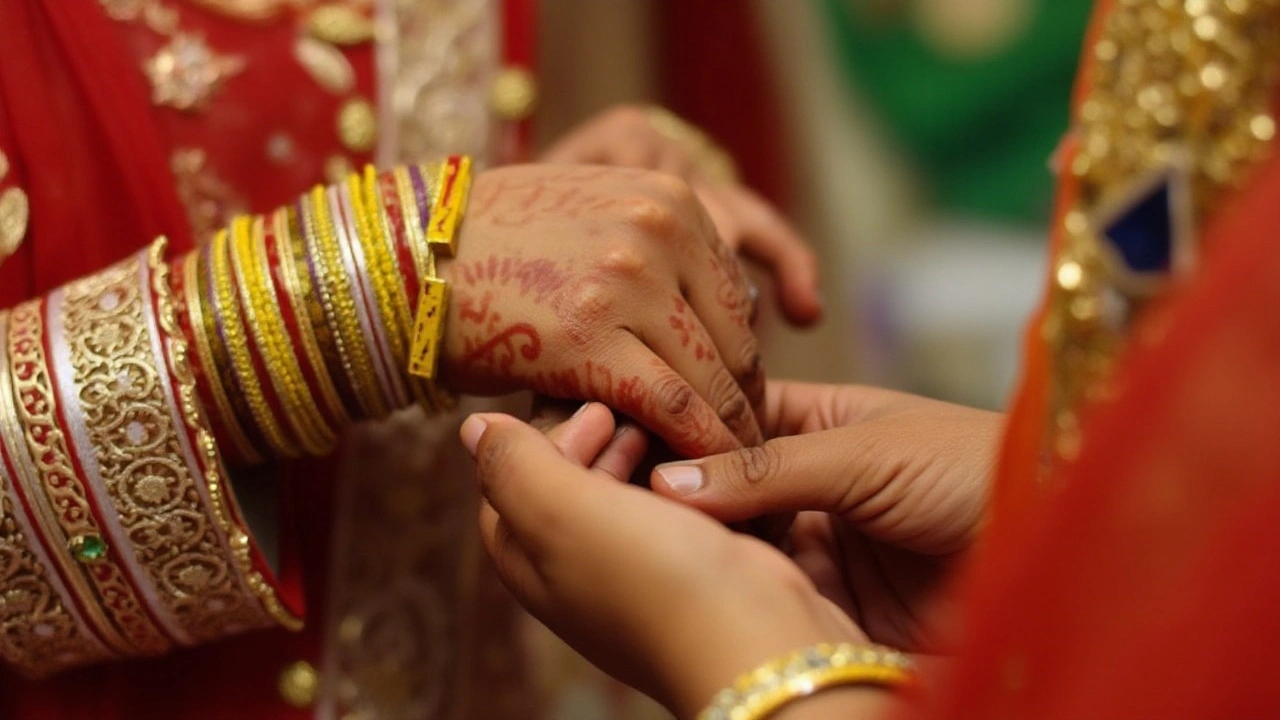
Mixing Modern Style with Traditional Elements
Blending the old with the new is an approach that's not just fashionable but also deeply representative of India's cultural diversity. In this dynamic era of fashion, the lines between what's considered classic and modern are beautifully blurred. From the shimmering cities to the quaint towns, people are embracing the art of mixing traditional Indian fashion with modern twists. Picture a sleek leather jacket adorning a vibrant sari or contemporary chunky sneakers paired with a kurta set; these combinations create an intriguing juxtaposition that speaks volumes about personal style and rebellion against conventional norms.
This trend goes beyond just clothing combinations; it taps into accessories like jewelry that bring these looks to life. Consider the regal charm of heritage statement pieces like maang tikka or jhumkas, now commonly worn with minimalist Western outfits. It's not about replacing the traditional but celebrating it through a new lens. According to fashion designer Sabyasachi Mukherjee, famed for his intricate, traditional designs, "It’s about reimagining what’s been passed down, a dialogue between the past and the present."
“It’s about reimagining what’s been passed down, a dialogue between the past and the present.” — Sabyasachi Mukherjee
One mustn't forget the significance of color in this blend. Choosing accessories that tie together elements from both styles often means playing with color palettes that harmonize with modern sensibilities while honoring traditional hues. Deep reds and golds meet soothing pastels and metallics. This marriage of colors can be seen in the rising trend of multi-layered necklaces, where traditional gold is often mixed with gemstones of various modern colors.
Exploring how to seamlessly incorporate these elements should also consider the suitability for different occasions. Everyday wear versus formal gatherings allows for different levels of experimentation. A simple churidar combined with a sleek belt and modern flats can transform a day look, while evening festivities offer a chance to be more adventurous with bold traditional necklaces enhanced by a sleek, modern clutch. It’s not just about mixing styles arbitrarily, but about understanding the context and enhancing the overall aesthetic.
Indian fashion’s beauty lies in its adaptability and its story-telling power through accessories. A bindi or a nose ring might carry significant meaning to the wearer, and when incorporated thoughtfully into a modern ensemble, it creates a rich tapestry of tradition meeting current trends. Such vibrant fusion not only makes a striking visual impact but also represents the wearer's unique identity, seamlessly shifting between cultural worlds.
To give you an idea of how versatile these combinations can be, here's a helpful table showcasing popular traditional pieces and potential modern pairings:
| Traditional Piece | Modern Pairing |
|---|---|
| Chandbali Earrings | Jeans and a chic blouse |
| Banarasi Dupatta | Little black dress |
| Kundan Choker | Off-the-shoulder gown |
Indonesia's success in cultivating this hybrid fashion culture underlines a broader global appreciation for such styles. The growing global appeal of Indian fashion accessories signifies not just a trend, but a movement towards inclusive, diverse fashion narratives.
Color Coordination and Style Tips
Understanding the art of color coordination can elevate your look, making your use of fashion accessories both strategic and stunning. In the rich tapestry of Indian fashion, colors don't just speak; they sing. From the vivid hues of silk sarees to the earthy tones of traditional Khadi, choosing the right color accessories can completely transform an outfit. The key is balance. You want your accessories to enhance your clothing, not overpower it. When selecting pieces, think about complementary colors. A deep maroon bangle set can accentuate the golden threads in a saree, while a turquoise scarf might bring out the subtleties in a pastel suit.
Accessories allow you to play with bold contrasts. For instance, pairing a vibrant, statement neckpiece with a simple monochrome Kurti can create a focal point. Bold colors generally work well with neutral backgrounds, enabling you to boldly wear a piece without it clashing with your outfit. Keep in mind the occasion, too. Rich, deep tones like royal blue or emerald green lend themselves to evening events, whereas lighter, breezy shades suit daytime functions more.
Patterns also play a vital role in coordinating accessories. If your attire is heavily patterned, consider subtle accessories that complement rather than compete with the prints. On the other hand, a plain outfit serves as a canvas, allowing you to experiment with intricate jewelry designs. Remember this insightful thought by fashion icon Diana Vreeland, “A little bad taste is like a nice splash of paprika. We all need a splash of bad taste—it’s hearty, it’s healthy, it’s physical. I think we could use more of it.”
If your outfit feels too predictable, it could be an opportunity to introduce an element of surprise through accessories.
Consider the traditional significance of colors as well. In India, specific colors carry deep cultural meanings. Red is often associated with weddings, symbolizing purity and love, while yellow signifies a fresh start, often worn during spring festivals. Understanding these nuances can guide your choices when dressing for cultural events.
Mixing modern style with traditional elements can also be rewarding. Try integrating contemporary pieces—like sleek metallic jewelry or bold geometric sunglasses—with traditional attire to keep your look fresh. Choosing the right fashion accessory involves considering the texture and material as well. A wooden statement necklace or rustic copper bracelets can lend an earthy vibe to more casual and bohemian looks.
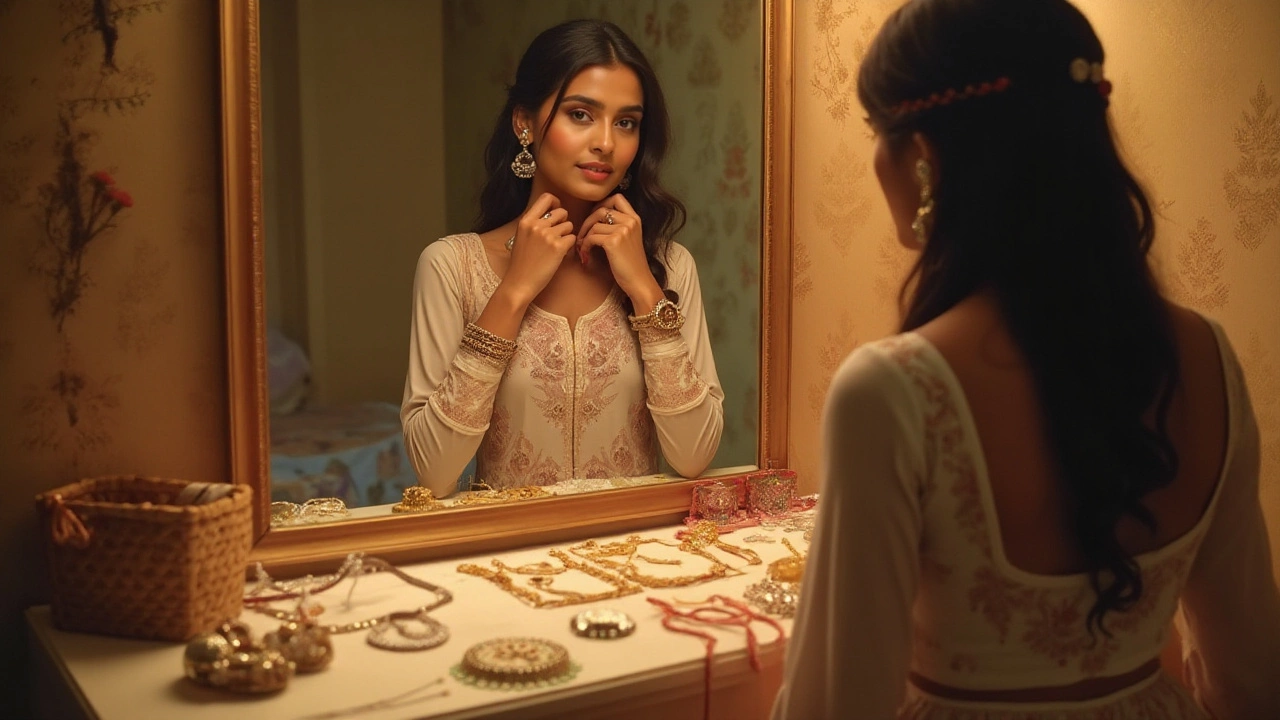
Personalizing Your Accessories Collection
Creating a truly unique accessories collection involves more than just acquiring pieces; it’s about curating a selection that resonates with your personal style and cultural heritage. One of the most exciting aspects of fashion is that it allows you to express individuality, emotions, and stories without a single word. When it comes to fashion accessories in India, the possibilities are boundless. From vibrant bangles that clink musically as you move to ornate necklaces that dazzle at every turn, personalizing your collection allows you to not only embrace fashion but to infuse it with your essence.
Begin by assessing your lifestyle and the occasions you most frequently attend. Are you regularly attending traditional events, office gatherings, or casual outings? Knowing this directs your choices, allowing you to maintain a versatile and functional collection. A great starting point is choosing timeless pieces that resonate with personal sentiments or heritage values. Perhaps you have family heirlooms that can be incorporated or modern pieces that wink at tradition. This fusion creates a fascinating tapestry of personal and cultural connections, making each piece in your collection a chapter of your story.
Investigate local artisans and markets to infuse your collection with unique, handcrafted pieces. Fashion is as much about discovery as it is about expression. By supporting local craftsmanship, not only do you enhance your collection, but you also contribute to preserving artistic traditions. Each handcrafted accessory carries with it the soul and passion of the creator, lending a deeper significance to your collection. A small expedition to a local market can yield treasures more valuable than any mass-produced item available online. Additionally, consider blending traditional motifs with modern sensibilities, an approach that creates an eclectic yet harmonious collection.
"Jewelry has the power to be this one little thing that can make you feel unique." – Jennie Kwon, renowned jewelry designer.
Explore various fashions, demographics, and sartorial inspirations drawn from Indian culture. Step out of your comfort zone by experimenting with unconventional pairings. You might find those classic golden jhumkas perfectly juxtaposed with a western ensemble, creating a statement that is both refreshing and compelling. This journey will lead you towards a more adventurous fashion sense that truly reflects your personality, bridging the past and present in ways that are remarkably innovative.
Maintain an eye towards balance, ensuring your collection covers a variety of accessorizing tips. You might want some standout earrings for those occasions when you wear simpler clothing or delicate pieces that enhance a busier ensemble. Finding the right balance is an art, one honed over time through trial and experimentation. Listening to feedback from friends, observing what garners the most positive reactions, and leaning into your instincts will help you refine your collection over time, evolving it to meet your changing fashion needs and styles.
Remember, fashion is a journey, not a destination. As you delve deeper into customizing your accessories, enjoy the spontaneity and fluidity of your choices. Fashion, after all, is not about fitting into a mold but about breaking it, about challenging preconceptions and setting new standards. Personalizing your collection should be a joyous adventure, a constant state of evolution, reflecting not just the many facets of Indian fashion but your personal narrative embedded within it.

